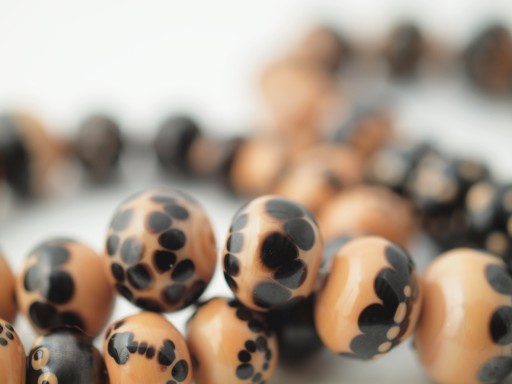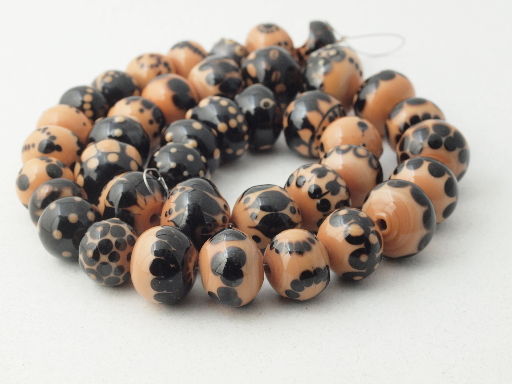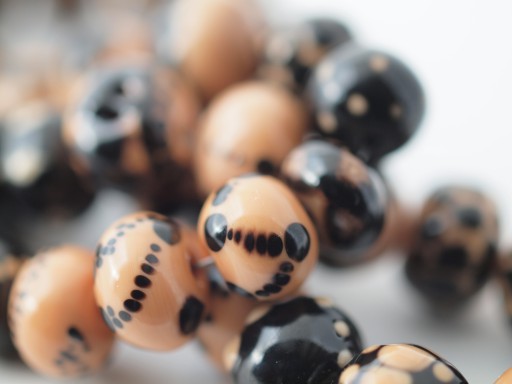So CiM donated a bunch of glass to our guild and in return asked that we post pictures about what we made with it, which does not seem to me a whole lot to ask. In particular, we were supposed to try doing Heather Trimlett's 40 bead challenge[1] which again I thought would be just delightful, as I love dots, and have ever since spending hours drooling over Kristina Logan's beads in the frontipiece of Cindy Jenkins’ Making Glass Beads, which I still regard as one of the best beginner books out there.

Closeup of my 40 bead challenge. I was trying to work with the soft edges to which the hematite was prone. In a very few cases, under very particular light, the black dots have a tiny hematite banding[2] which was absolutely gorgeous, but needless to say, I wasn't able to photograph it.
But—and you knew there was gonna be a but—there were some issues.
First, again in the interests of full disclosure, I'm not actually that great at making this sort of dot bead. Frankly it requires working pretty slowly, and pretty cold, and that's really hard on my joints: my fifth fingers tend to go numb, after a few days my lateral epicondylitis and carpal tunnel start acting up...there's a reason I like making beads that don't involve a lot of slow mandrel turning.
Second, as one of the people who really did a lovely job with this challenge,[3] Haley Tsang noted this particular technique is best done with a dark transparent and light opaque (the heavy silver bearing glasses, such as Black Pearl, that she used in her challenge, are, like black glass, actually dark transparents.)
I ended up with nutmeg and hematite, both of which are nice glasses, and lovely colors. However, hematite, despite looking like a black, does not act like one. This made me nuts cuz had it been a properly stiff glass, the combo of the somewhat color-shifting nutmeg and the silvery pewter shine to glossy black of the hematite would have been absolutely stunning. Alas, I swear hematite crawls as badly as petroleum green, which is sort of the go-to example for this type of behavior. I realized I basically had two options:

2 color 40 bead challenge. Completed roughly 06mar2014. Yes, I did finally get tired of the no-tool rule and marver a bit. However, I only used glass itself to rake: I presumed that was fair-game, since we used glass to put the dots on in the first place. [4]
- Fight with the glass through the entire challenge. Not fun
- Try to work with the glass, incorporating the crawling.
I have an absolutely fantastic book on shibori (called, oddly enough, Shibori) that has page after page of really gorgeous variations on this Japanese string and wrap (‘tie-dye’) technique. Part of the beauty of shibori is presumed to be the rather soft edges of the dye seeping into the regions restricted by string-binding, or clamping, or whathaveyou. This particular book specializes in the Arimatsu region, where they developed a faster, and thus more commercially viable, method of dying on a pole. But I digress. The point is that I used the examples in the book to attempt to change my thinking about what constituted ‘success’ in the project.
I finished 40 beads before I got very far with the ‘shibori’ technique. I was incredibly frustrated because although I knew I couldn't make crisp-edged dots, let alone stacked dots, that's what I wanted to do. Moreover, nutmeg is such a pretty color, and so perfect for sculptural faces, I felt I was wasting it for this purpose, which would be better served with plain ole (inexpensive) white and cobalt, or white and black.
Since I couldn't do stacked dots, I figured I might as well make the beads hollow—which I did for all but the first bead. (Stacked dots require a lot of base to melt into, which thin walled hollows don't provide.) It meant a lot of futzing around, carefully melting the lips of the hollows together, or pinching them together with the end of the glass rod, rather than giving them a quick swipe with the torchtop marver to close everything up (because of the no-tools rule). I learn slowly so I repeated a lot of designs, and by the end my technique was improving, and the dots were getting somewhat crisper. But it would probably take at least another hundred or so beads before I really became at all comfortable with ‘shibori’ approach, and because my hoarding issues, I'd probably need to purchase 3–4x the amount of glass the project would require to relax enough to do that.
Besides, I wanna do the stacked crisp dots, the graphic quality of which just fascinates me. Not too long ago I took an Amy Waldman Smith class, which played with (very) crisp edges; along with Lani Ching, Terri Casperi Schmidt, Larry Brickman, warring states beads in general and of course Kristina Logan constitute what are perhaps my very favorite style of beads[5] So I've returned to doing red, white and blue beads, which have the advantage of using cheap glass, and being useful for my various omiyage projects.
But it was heartening to realize that the small nutmeg dots on black came out a little better the second time I tried them.[6] I did learn some things, which I hope will eventually improve my dotting skills.
Someday.
UPDATE: updated the Heather Trimlett link, 05jan2020
[1]This is not a new idea: I tried this roughly a decade ago, with not much better results.
[2]Similar to the sulphur reaction between turquoise and ivory
[3]I treated myself to an early bday prezzie, a ‘clover’ 3dot/floral motif type similar to the one all the way to the left on her for-sale pic at the bottom of the post...yum!
[4]These pix don't actually look that bad, at least to me: that's what decent lighting and a nice lens will do for you—rescue some really crappy looking beads. Yay photography. I admit, having all the beads be the same two colors also helps, because it causes the eye to see them as a single mass, downplaying the individual awfulness.
[5]Well, some days. Other days it's Leah Fairbanks florals, or frit and powder....
[6]The nutmeg tended to fall into the black, which is why the bulk of my beads are nutmeg-background. Which again annoyed me, because I wanted to ‘save’ the nutmeg and use more of the black. Despite both colors being free! Did I mention a hoarding tendency...?
Unless otherwise noted, text, image and objects depicted therein copyright 1996--present sylvus tarn.
Sylvus Tarn